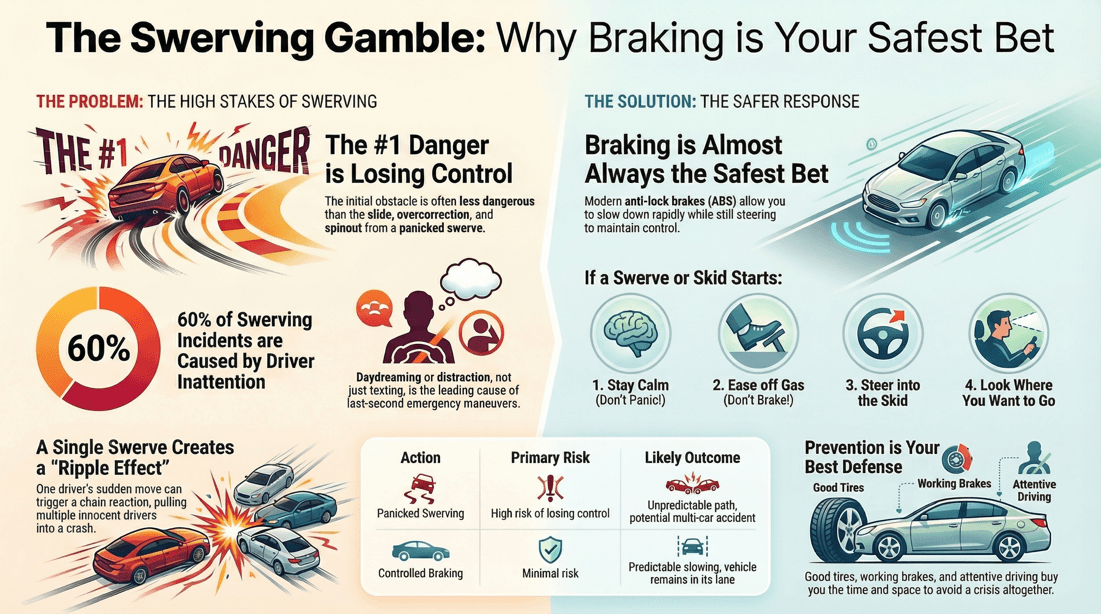
Swerving
☠️ Alert:
🛈 Info:
? Questions:


☠️ Dangers of swerving
Loss of Vehicle Control:
Skidding: Sudden swerving can cause the vehicle to skid, especially on wet or slippery roads, leading to a loss of control. Overcorrection: Drivers may overcorrect after a swerve, resulting in a fishtail or spinout, which can cause the vehicle to veer off the road or into oncoming traffic.
Increased Risk of Collisions:
Side-Impact Collisions: Swerving into another lane can cause side-impact collisions with vehicles in adjacent lanes. Head-On Collisions: Swerving into oncoming traffic lanes can result in head-on collisions, which are often severe and potentially fatal. Multiple Vehicle Accidents: Sudden swerving can cause a chain reaction of evasive maneuvers by other drivers, leading to multi-vehicle pile-ups.
Impact on Other Drivers:
Startling Other Drivers: Sudden and unexpected swerves can startle other drivers, causing them to react unpredictably and potentially lose control. Blocked Pathways: Swerving can create obstacles for other drivers, forcing them to take evasive actions that can lead to accidents.
Reduced Reaction Time:
Insufficient Time to React: Swerving often occurs with little time to react, reducing the effectiveness of the maneuver and increasing the risk of collision. Delayed Response: Other drivers may not have enough time to respond to a swerving vehicle, leading to accidents.
Rollovers:
High Center of Gravity Vehicles: Swerving can cause vehicles with a high center of gravity, such as SUVs and trucks, to roll over, resulting in severe injuries or fatalities. Sharp Turns: Making sharp, abrupt turns increases the risk of a rollover, especially at high speeds.
Pedestrian and Cyclist Hazards:
Sidewalks and Shoulders: Swerving onto sidewalks or shoulders can put pedestrians and cyclists at serious risk of injury or death. Crosswalks: Abrupt maneuvers near crosswalks can endanger pedestrians who are crossing the street.
Inadequate Space:
Narrow Roads: Swerving on narrow roads or in areas with limited space can lead to collisions with barriers, guardrails, or parked vehicles. Obstacles: Sudden swerving may not account for obstacles such as road signs, medians, or construction zones, increasing the likelihood of collisions.
Distracted and Impaired Driving:
Driver Distraction: Swerving can be a result of driver distraction, such as using a phone, which already compromises vehicle control. Impaired Driving: Drivers under the influence of alcohol or drugs are more likely to swerve and less likely to control the vehicle effectively.
Mechanical Failures:
Tire Blowouts: Swerving can cause tire blowouts or exacerbate existing tire damage, leading to further loss of control. Steering and Suspension Damage: Abrupt movements can strain the vehicle's steering and suspension systems, potentially causing mechanical failures.
Prevention and Mitigation:
Stay Alert and Focused: Always pay attention to the road and avoid distractions such as mobile phones or in-car entertainment systems. Maintain Safe Speeds: Drive at speeds appropriate for road and weather conditions, allowing more time to react to potential hazards. Keep a Safe Following Distance: Maintain a safe distance from the vehicle in front to reduce the need for sudden evasive maneuvers. Use Mirrors and Check Blind Spots: Regularly check mirrors and blind spots to be aware of surrounding traffic before making lane changes or turns. Plan Ahead: Anticipate potential hazards and plan movements in advance to avoid sudden swerves. Avoid Aggressive Driving: Refrain from aggressive driving behaviors such as tailgating, rapid lane changes, and speeding. Stay Calm: If faced with a potential collision, remain calm and use controlled steering and braking rather than abrupt swerves.
🛈 What to
do if you see a car swerving
Keep a Safe Distance:
Increase Following Distance: Maintain a safe following distance from the swerving vehicle to give yourself more time to react if the situation worsens. Avoid Close Proximity: If possible, change lanes to distance yourself from the swerving car. Do not drive directly alongside or too close behind it.
Alert Other Drivers:
Hazard Lights: Consider turning on your hazard lights to alert other drivers to the potential danger ahead. Hand Signals: If safe, use hand signals or honk your horn briefly to catch the attention of other nearby drivers.
Stay Calm and Focused:
Stay Vigilant: Keep an eye on the swerving vehicle while remaining aware of your surroundings and other traffic. Do Not Panic: Stay calm and avoid making sudden movements that could escalate the situation.
Do Not Attempt to Pass:
Avoid Passing: Do not try to pass the swerving vehicle, as it may change lanes unpredictably and cause a collision. Wait for Safety: Only pass the vehicle when you are certain it is safe and the car has stabilized or pulled over.
Call for Help:
Emergency Services: If you believe the driver may be impaired or experiencing a medical emergency, call 911 or your local emergency number. Provide the dispatcher with the vehicle’s location, direction of travel, and description. Report the Behavior: Describe the erratic driving behavior to the dispatcher to help authorities assess the situation accurately.
Observe and Record Details:
Vehicle Description: Note the make, model, color, and license plate number of the swerving vehicle. Location and Direction: Record the location, road name, and direction of travel to provide accurate information to emergency services.
Do Not Engage:
Avoid Confrontation: Do not try to signal, confront, or interact with the swerving driver. Your primary goal is to stay safe and alert authorities. Stay Neutral: Focus on maintaining a safe driving environment for yourself and other road users.
Prepare for Unexpected Movements:
Be Ready to React: Anticipate sudden lane changes, stops, or accelerations from the swerving vehicle. Maintain Control: Keep both hands on the steering wheel and be prepared to take evasive action if necessary.
Stay Informed:
Traffic Updates: Listen to traffic reports or use navigation apps that provide real-time updates on road conditions and incidents.
Follow Up:
Check on Outcome: If possible, safely check on the outcome after reporting the incident to ensure that emergency services have responded and the situation is being handled.
? What causes a car to swerve?
Driver-Related Causes:
Texting or Using a Phone: Taking eyes off the road to look at a phone. Eating or Drinking: Handling food or beverages while driving. Adjusting Controls: Changing radio stations, climate controls, or using in-car entertainment systems.
Alcohol or Drug Use: Driving under the influence of alcohol or drugs impairs judgment and reaction times. Fatigue: Drowsy driving can cause micro-sleeps or lapses in attention.
Health Issues: Sudden medical conditions like seizures, heart attacks, or fainting spells.
Road Rage: Engaging in aggressive maneuvers due to frustration or anger. Reckless Driving: Deliberate actions such as rapid lane changes and tailgating.
Vehicle-Related Causes:
Tire Blowouts: A sudden tire failure can cause the vehicle to swerve unexpectedly. Brake Failure: Malfunctioning brakes can lead to uneven braking forces, causing the car to veer. Steering Problems: Issues with the steering mechanism can lead to loss of control.
Worn Tires: Bald or unevenly worn tires reduce traction and can cause swerving. Suspension Issues: Problems with the suspension system can affect vehicle stability.
Road-Related Causes:
Wet or Icy Roads: Reduced traction on slippery surfaces can cause swerving. Potholes and Debris: Hitting potholes, road debris, or uneven surfaces can cause sudden changes in direction.
Sharp Turns: Unexpected sharp turns or curves can catch drivers off guard. Construction Zones: Narrow lanes and sudden lane shifts in construction areas can cause swerving.
Environmental Causes:
Rain: Wet roads reduce traction, increasing the risk of hydroplaning and swerving. Snow and Ice: Icy conditions make it difficult to control the vehicle. Fog: Reduced visibility can lead to sudden maneuvers.
Strong Gusts: High winds can push the vehicle sideways, causing it to swerve.
External Factors:
Animals: Swerving to avoid hitting animals crossing the road. Other Vehicles: Evasive maneuvers to avoid collisions with other vehicles that suddenly stop or change lanes. Pedestrians: Swerving to avoid hitting pedestrians who step into the road unexpectedly.
Prevention:
Stay Focused: Avoid distractions and keep your attention on the road. Avoid Impairment: Never drive under the influence of alcohol, drugs, or when excessively tired. Maintain Your Vehicle: Regularly check and maintain your tires, brakes, and steering system. Adjust for Conditions: Drive at speeds appropriate for road and weather conditions. Stay Calm: React calmly and avoid sudden, aggressive maneuvers. Plan Ahead: Anticipate potential hazards and plan your route accordingly.
? Is it safe to swerve to avoid an obstacle?
Assess the Situation:
Type of Obstacle: Consider the size and type of obstacle. Small debris might not warrant a swerve, whereas a larger object or an animal might. Traffic Conditions: Check for traffic in adjacent lanes. Swerving without ensuring a clear path can lead to collisions with other vehicles.
Alternative Actions:
Braking: In many cases, it's safer to brake firmly rather than swerve. Modern vehicles are equipped with anti-lock braking systems (ABS) that allow for controlled braking without losing steering control. Evasive Maneuvering: If you must swerve, try to make a controlled, gentle turn rather than a sharp swerve. This reduces the risk of losing control.
Potential Risks of Swerving:
Loss of Control: Abrupt swerving can cause your vehicle to skid or roll over, especially at high speeds or on slippery roads. Secondary Collisions: Swerving can lead to collisions with vehicles in adjacent lanes or cause a chain reaction of evasive maneuvers by other drivers. Pedestrian and Cyclist Hazards: Swerving onto sidewalks or shoulders can endanger pedestrians and cyclists.
Road Conditions:
Wet or Icy Roads: Swerving on slippery surfaces significantly increases the risk of losing control. Curves and Hills: On winding roads or slopes, swerving can lead to rollovers or off-road accidents.
Vehicle Factors:
Type of Vehicle: Vehicles with a high center of gravity, like SUVs and trucks, are more prone to rollovers when swerving. Condition of Vehicle: Ensure your tires, brakes, and suspension are in good condition to handle sudden maneuvers if necessary.
Driver Preparedness:
Defensive Driving: Always drive defensively, maintaining a safe following distance and being aware of potential hazards. Training: Advanced driver training can teach techniques for handling emergency situations without losing control.
General Guidelines:
Stay Calm: If you encounter an obstacle, stay calm and avoid making sudden, jerky movements. Brake First: If you have enough distance, try to brake firmly and steer gently around the obstacle if necessary. Assess Traffic: Always check for vehicles in adjacent lanes before swerving. Practice Safe Driving: Regularly practice defensive driving techniques and stay alert to your surroundings.
Conclusion:
? What should I do if my car starts to swerve?
Stay Calm
Remain Calm : Panic can lead to overcorrecting, which may worsen the situation. Keep a clear mind to respond appropriately.
Ease Off the Accelerator
Gradual Deceleration : Slowly take your foot off the accelerator. Abrupt changes in speed can make the swerve worse. Do Not Brake Suddenly : Slamming on the brakes can cause a loss of control, especially if the road is slippery.
Steer Gently
Counter-Steer : If the rear of the car is sliding out (oversteering), gently steer into the direction of the skid to regain control. For example, if the rear slides right, steer right. Avoid Over-Correcting : Excessive steering can cause the car to swerve in the opposite direction, leading to a more dangerous situation.
Look Where You Want to Go
Focus on Your Path : Keep your eyes on the direction you want the car to go, not on the obstacle you're trying to avoid. This helps guide your steering naturally.
Gradual Braking (if necessary)
Controlled Braking : If you need to slow down more, apply the brakes gently and progressively. If your car has anti-lock brakes (ABS), apply steady pressure; the system will prevent wheel lock-up. No Brakes on Ice : On icy roads, avoid using the brakes as it can cause the wheels to lock, worsening the skid.
Adjust for Road Conditions
Wet or Icy Roads : Be aware that traction is reduced on wet or icy roads. Reduce your speed and increase following distances to allow for more reaction time. Gravel or Loose Surfaces : On loose surfaces like gravel, steer and brake gently to avoid skidding.
Regain Control
Steady the Vehicle : Once you've regained control, slowly bring the car back into your lane and continue to drive cautiously. Stop if Necessary : If the swerve was severe or you're unsure about the car's condition, pull over safely to the side of the road to assess the situation.
Preventive Measures
Check Tire Condition : Ensure your tires are in good condition, properly inflated, and have adequate tread depth. Worn or under-inflated tires can contribute to loss of control. Maintain Safe Speeds : Driving at appropriate speeds for the road conditions reduces the risk of swerving. Avoid Sudden Movements : Make steering, braking, and accelerating inputs smooth and gradual to maintain control.
Dealing with Aquaplaning or Hydroplaning
Do Not Brake or Turn Suddenly : If you feel the car floating on water, ease off the accelerator and steer straight until you regain traction.
? How can I prevent my car from swerving?
Maintain Your Vehicle
Tire Maintenance : Proper Inflation : Ensure your tires are inflated to the manufacturer’s recommended pressure. Under-inflated or over-inflated tires can reduce traction. Tire Tread : Check the tread depth regularly. Worn tires are more prone to slipping, especially on wet or icy roads. Tire Condition : Replace tires that are damaged or excessively worn. Also, ensure tires are properly balanced and aligned. Suspension and Steering : Inspect Regularly : Have your suspension and steering systems checked regularly. Worn components can cause instability and uneven tire wear. Brakes : Functional Brakes : Keep your brakes in good condition. Faulty brakes can lead to uneven stopping power, increasing the risk of swerving. Weight Distribution : Load Evenly : Ensure your vehicle is not overloaded and that weight is evenly distributed. Improper weight distribution can affect handling.
Drive According to Road Conditions
Adjust Speed : Drive at a safe speed for the conditions. Slow down on wet, icy, or gravel roads to maintain better control. Increase Following Distance : Give yourself more space from the vehicle ahead, especially in adverse weather. This provides more time to react and stop safely. Avoid Sudden Maneuvers : Make steering, braking, and accelerating inputs smooth and gradual. Sudden actions can lead to loss of control, especially in low-traction conditions. Avoid Puddles and Standing Water : Driving through deep water can cause hydroplaning, where your tires lose contact with the road.
Be Aware of Road Hazards
Stay Alert : Be vigilant for road hazards such as potholes, debris, or uneven surfaces that could cause a loss of control. Know the Road : Familiarize yourself with the roads you frequently travel. Be aware of areas prone to ice, sharp curves, or other hazards. Avoid Distractions : Stay focused on the road. Distractions can lead to delayed reactions and improper handling of the vehicle.
Use Proper Driving Techniques
Proper Grip : Hold the steering wheel with both hands at the 9 and 3 o’clock positions for maximum control. Brake Properly : Use smooth, steady pressure on the brakes. For vehicles with anti-lock brakes (ABS), apply firm pressure to allow the system to work effectively. Accelerate Smoothly : Avoid sudden acceleration, especially on slippery surfaces. This can cause wheel spin and loss of control.
Adapt to Weather Conditions
Wet or Icy Roads : Reduce speed, increase following distance, and avoid abrupt movements. Use winter tires in snowy conditions. Fog and Low Visibility : Use fog lights if available and reduce speed. Increase following distance and use low-beam headlights.
Avoid Aggressive Driving
No Tailgating : Maintain a safe following distance. Tailgating can lead to sudden braking, which may cause a loss of control. Smooth Lane Changes : Signal in advance and change lanes gradually. Sudden lane changes can lead to swerving, especially at high speeds.
Handle Emergencies Calmly
Practice Defensive Driving : Be prepared for unexpected situations, such as sudden stops or erratic behavior from other drivers. Know How to Correct Skids : If your car starts to skid, steer in the direction you want to go, and avoid over-correcting.
? Can swerving damage your car?
Tire Damage:
Wear and Tear: Abrupt swerving can cause uneven wear on your tires, reducing their lifespan. Blowouts: Sudden sharp turns or hitting curbs while swerving can cause tire blowouts.
Suspension and Steering System:
Stress and Strain: The suspension and steering components can experience excessive stress during sudden maneuvers, leading to wear or failure. Alignment Issues: Swerving can knock your wheels out of alignment, causing uneven tire wear and poor handling.
Brake System:
Excessive Use: Abruptly swerving often involves hard braking, which can overheat and wear down brake components faster than normal.
Body and Frame:
Collision Damage: Swerving can result in collisions with curbs, guardrails, or other vehicles, causing dents, scratches, and structural damage. Underbody Damage: Swerving off the road can lead to hitting debris or uneven surfaces, potentially damaging the underbody, exhaust system, or fuel tank.
Electronic Stability Control (ESC) and Anti-lock Braking System (ABS):
Component Strain: Frequent activation of ESC and ABS due to swerving can put additional strain on these systems, leading to potential malfunctions or failures.
Transmission and Drivetrain:
Shock Loads: Abrupt changes in direction can cause shock loads on the transmission and drivetrain, leading to potential wear and damage.
Suspension Components:
Ball Joints and Bushings: Sudden and sharp maneuvers can accelerate wear on ball joints and bushings, leading to reduced handling performance and potential failure.
Prevention and Mitigation:
Maintain Your Vehicle: Regularly inspect and maintain tires, brakes, and suspension components. Drive Defensively: Stay alert and avoid distractions to reduce the need for sudden maneuvers. Slow Down: Reduce speed when approaching potential hazards to give yourself more time to react safely. Practice Controlled Steering: Use smooth and controlled steering inputs rather than sharp, abrupt movements.